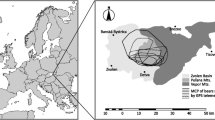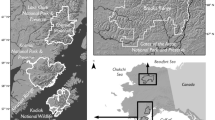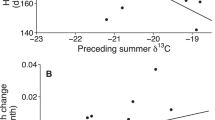Abstract
Investigating factors underlying human-wildlife conflicts in agricultural landscapes is important for both preventing crop damage and wildlife conservation. Although environments surrounding crop fields are considered causal factors, incorporating individual aspects of animals, such as demographic and physical characteristics, into the investigation may aid the prediction of how nuisance control affects wildlife population structures. Here, we assessed the relationship of corn consumption by Hokkaido brown bears (Ursus arctos) with both demographic (sex and age) and physical (body size) characteristics and environmental factors (human presence and crop accessibility). We estimated the proportion of corn in the lifespan diet for both female (n = 61) and male (n = 62) bears using carbon and nitrogen stable isotope analyses. Then, we analyzed the factors correlated with corn consumption using a generalized linear model. Female and male bears consumed corn from 1.3 to 30.9% and 1.3 to 42.0% of their lifespan diet, respectively. Corn consumption by female bears was not correlated with any explanatory variables, whereas that of male bears was positively correlated with their body size and crop accessibility but negatively correlated with human presence. Large male bears were more likely to have consumed more corn than small male bears, but the selective harvest of large bears may cause dwarfism of their overall population, impacting the local population dynamics. To reduce agricultural damage and population structure alteration of brown bears, the opportunity for them to learn to eat crops must be eliminated through border management between forests and agricultural fields and the relocation of agricultural fields when possible.




Similar content being viewed by others
References
Administrative Management Agency (1973) Ministerial notification no. 143 of the administrative management agency. Prime Minister’s Office of Japan, Japan
Ambrose SH, DeNiro MJ (1986) Reconstruction of African human diet using bone collagen carbon and nitrogen isotope ratios. Nature 319:321–324
Andersson M, Iwasa Y (1996) Sexual selection. Trends Ecol Evol 11:53–58
Bartareau TM, Cluff HD, Larter NC (2011) Body length and mass growth of the brown bear (Ursus arctos) in northern Canada: model selection based on information theory and ontogeny of sexual size dimorphism. Can J Zool 89:1128–1135
Bartón K (2013) Model selection and model averaging based oninformation criteria (AICC and alike). http://cran.r-project.org/web/packages/MuMIn/index.html. Accessed 10 Dec 2015
Ben-David M, Titus K, Beier LR (2004) Consumption of salmon by Alaskan brown bears: a trade-off between nutritional requirements and the risk of infanticide? Oecologia 138:465–474
Bocherens H, Argant A, Argant J, Billiou D, Crégut-Bonnoure E, Donat-Ayache B, Philippe M, Thinon M (2004) Diet reconstruction of ancient brown bears (Ursus arctos) from Mont Ventoux (France) using bone collagen stable isotope biogeochemistry (13C, 15N). Can J Zool 82:576–586
Bojarska K, Selva N (2012) Spatial patterns in brown bear Ursus arctos diet: the role of geographical and environmental factors. Mammal Rev 42:120–143
Breck SW, Williams CL, Beckmann JP, Matthews SM, Lackey CW, Beecham JJ (2008) Using genetic relatedness to investigate the development of conflict behavior in black bears. J Mammal 89:428–434
Ciarniello LM, Boyce MS, Seip DR, Heard DC (2007) Grizzly bear habitat selection is scale-dependent. Ecol Appl 17:1424–1440
Cribari-Neto F, Zeileis A (2010) Beta regression in R. J Stat Softw 34:1–24
Dahle B, Swenson JE (2003a) Home ranges in adult Scandinavian brown bears (Ursus arctos): effect of mass, sex, reproductive category, population density and habitat type. J Zool 260:329–335
Dahle B, Swenson JE (2003b) Seasonal range size in relation to reproductive strategies in brown bears Ursus arctos. J Anim Ecol 72:660–667
Deniro MJ, Epstein S (1981) Influence of diet on the distribution of nitrogen isotopes in animals. Geochim Cosmochim Acta 45:341–351
Ditmer MA, Garshelis DL, Noyce KV, Haveles AW, Fieberg JR (2016) Are American black bears in an agricultural landscape being sustained by crops? J Mammal 97:54–67
Elfström M, Zedrosser A, Støen OG, Swenson JE (2014) Ultimate and proximate mechanisms underlying the occurrence of bears close to human settlements: review and management implications. Mammal Rev 44:5–18
Elgmork K (1978) Human impact on a brown bear population (Ursus arctos L.). Biol Conserv 13:81–103
Gende SM, Quinn TP (2004) The relative importance of prey density and social dominance in determining energy intake by bears feeding on Pacific salmon. Can J Zool 82:75–85
Graham K, Boulanger J, Duval J, Stenhouse G (2010) Spatial and temporal use of roads by grizzly bears in west-central Alberta. Ursus 21:43–56
Hata A, Takada MB, Nakashita R, Fukasawa K, Oshida T, Ishibashi Y, Sato Y (2017) Stable isotope and DNA analyses reveal the spatial distribution of crop-foraging brown bears. J Zool 303:207–217
Herrero S (1983) Social behaviour of black bears at a garbage dump in Jasper National Park. Bears Their Biol Manag 5:54–70
Herrero S, Smith T, DeBruyn TD, Gunther K, Matt CA (2005) Brown bear habituation to people—safety, risks, and benefits. Wildl Soc Bull 33:362–373
Hilderbrand GV, Gustine DD, Mangipane BA, Joly K, Leacock W, Mangipane LS, Erlenbach J, Sorum M, Cameron M, Belant JL, Cambier T (2018) Body size and lean mass of brown bears across and within four diverse ecosystems. J Zool 305:53–62
Hokkaido Prefectural Government (2016) Hokkaido government subprefectural bureau information. www.pref.hokkaido.lg.jp/gyosei/shicho/index.htm. Accessed 1 Dec 2016
Hokkaido Prefectural Government (2017a) Hokkaido brown bear management plan. www.pref.hokkaido.lg.jp/ks/skn/higuma/hokkaido_bear_management_plan.pdf. Accessed 10 Dec 2015
Hokkaido Prefectural Government (2017b) Population of Hokkaido. www.pref.hokkaido.lg.jp/file.jsp?id=923083. Accessed 1 Feb 2017
Hopkins JB (2013) Use of genetics to investigate socially learned foraging behavior in free-ranging black bears. J Mammal 94:1214–1222
Lee-Thorp JA, Sealy JC, van der Merwe NJ (1989) Stable carbon isotope ratio differences between bone collagen and bone apatite, and their relationship to diet. J Archaeol Sci 16:585–599
Luque MH, Stokes AW (1976) Fishing behaviour of Alaska brown bear. Bears Their Biol Manag 3:71–78
Mace RD, Waller JS, Manley TL, Lyon LJ, Zuuring H (1996) Relationships among grizzly bears, roads and habitat in the Swan Mountains Montana. J Appl Ecol 33:1395–1404
Mano T (1994) Home range and habitat use of brown bears in the Southwestern Oshima Peninsula, Hokkaido. Bears Their Biol Manag 9:319–325
Mano T (2009) Causes and prevention of brown bear related conflicts in the human habitat in Hokkaido. In: Oi T, Ohnishi N, Koizumi T, Okouchi I (eds) FFPRI scientific meeting report 4 biology of bear intrusions. Forestry and Forest Products Research Institute, Ibaraki, pp 23–27
Mano T, Tsuruga H (2011) Behavior change of brown bears implied by the long-term kill monitoring in the Oshima Peninsula region, Hokkaido. In: Mano T (ed) Study for avoidance of conflict with brown bears in the Oshima Penisula region: creation of bear damage hazard maps. Institute of Environmental Sciences, Hokkaido Research Organization, Sapporo, pp 4–12
Martin J, Basille M, Van Moorter B, Kindberg J, Allainé D, Swenson JE (2010) Co** with human disturbance: spatial and temporal tactics of the brown bear (Ursus arctos). Can J Zool 88:875–883
Matsubayashi J, Tayasu I (2019) Collagen turnover and isotopic records in cortical bone. J Archaeol Sci 106:37–44
Matsubayashi J, Morimoto JO, Tayasu I, Mano T, Nakajima M, Takahashi O, Kobayashi K, Nakamura F (2015) Major decline in marine and terrestrial animal consumption by brown bears (Ursus arctos). Sci Rep 5:9203
Matsubayashi J, Tayasu I, Morimoto JO, Mano T (2016) Testing for a predicted decrease in body size in brown bears (Ursus arctos) based on a historical shift in diet. Can J Zool 94:489–495
Mazur R, Seher V (2008) Socially learned foraging behaviour in wild black bears, Ursus americanus. Anim Behav 75:1503–1508
Minagawa M, Wada E (1984) Stepwise enrichment of 15N along food chains: further evidence and the relation between δ15N and animal age. Geochim Cosmochim Acta 48:1135–1140
Ministry of Environment (2015) 5th vegetation survey. http://www.biodic.go.jp. Accessed 10 Sept 2015
Ministry of Internal Affairs and Internal Communications (2015) Population census. Statistics bureau, ministry of internal affairs and internal communications. https://www.e-stat.go.jp/gis. Accessed 23 Dec 2015
Mundy KRD, Fuller WA (1964) Age determination in the grizzly bear. J Wildl Manag 28:863–866
Nagasaka A, Tsuruga H, Mano T, Furuya M, Suzuki T, Kon H, Terada A (2011) Brown bear-caused damage hazard maps based on locational conditions of farmlands in Mori town, Hokkaido, Japan. In: Mano T (ed) Study for avoidance of conflict with brown bears in the Oshima Penisula region: creation of bear damage hazard maps. Institute of Environmental Sciences, Hokkaido Research Organization, Sapporo, pp 37–58
Nellemann C, Støen OG, Kindberg J, Swenson JE, Vistnes I, Ericsson G, Katajisto J, Kaltenborn BP, Martin J, Ordiz A (2007) Terrain use by an expanding brown bear population in relation to age, recreational resorts and human settlements. Biol Conserv 138:157–165
Nielsen SE, Shafer AB, Boyce MS, Stenhouse GB (2013) Does learning or instinct shape habitat selection? PLoS ONE 8:e53721
Northrup JM, Stenhouse GB, Boyce MS (2012) Agricultural lands as ecological traps for grizzly bears. Anim Conserv 15:369–377
Ordiz A, Stoen OG, Delibes M, Swenson JE (2011) Predators or prey? Spatio-temporal discrimination of human-derived risk by brown bears. Oecologia 166:59–67
Ordiz A, Støen OG, Sæbø S, Kindberg J, Delibes M, Swenson JE (2012) Do bears know they are being hunted? Biol Conserv 152:21–28
Parnell AC, Inger R, Bearhop S, Jackson AL (2010) Source partitioning using stable isotopes: co** with too much variation. PLoS ONE 5:e9672
Phillips DL, Inger R, Bearhop S, Jackson AL, Moore JW, Parnell AC, Semmens BX, Ward EJ (2014) Best practices for use of stable isotope mixing models in food-web studies. Can J Zool 92:823–835
QGIS Development Team (2020) QGIS geographic information system. Open source geospatial foundation project. http://qgis.osgeo.org. Accessed 5 Mar 2020
R Core Team (2018) R: a language and environment for statistical computing. R Foundation for Statistical Computing, Vienna
Robbins CT, Schwartz CC, Felicetti LA (2004) Nutritional ecology of ursids: a review of newer methods and management implications. Ursus 15:161–171
Rosing MN, Ben-David M, Barry RP (1998) Analysis of stable isotope data: a K nearest-neighbors randomization test. J Wildl Manag 62:380–388
Sánchez MCM, Cushman SA, Saura S (2014) Scale dependence in habitat selection: the case of the endangered brown bear (Ursus arctos) in the Cantabrian Range (NW Spain). Int J Geogr Inf Sci 28:1531–1546
Sato Y (2005) Food habits of brown bear-regional difference and annual variation. Mamm Sci 45:79–84
Sato Y, Mano T, Takatsuki S (2005) Stomach contents of brown bears Ursus arctos in Hokkaido, Japan. Wildl Biol 11:133–144
Sato Y, Kobayashi Y, Urata T, Takatsuki S (2008) Home range and habitat use of female brown bear (Ursus arctos) in Urahoro, eastern Hokkaido, Japan. Mamm Study 33:99–109
Schilling MF (1986) Multivariate two-sample tests based on nearest neighbors. J Am Stat Assoc 81:799–806
Schoeninger MJ, DeNiro MJ (1984) Nitrogen and carbon isotopic composition of bone collagen from marine and terrestrial animals. Geochim Cosmochim Acta 48:625–639
Sealy JC, van der Merwe NJ, Thorp JAL, Lanham JL (1987) Nitrogen isotopic ecology in southern Africa: implications for environmental and dietary tracing. Geochim Cosmochim Acta 51:2707–2717
Shivik JA, Ruid D, Willging RC, Mock KE (2011) Are the same bears repeatedly translocated from corn crops in Wisconsin? Ursus 22:114–119
Takahata C, Nielsen SE, Takii A, Izumiyama S (2014) Habitat selection of a large carnivore along human-wildlife boundaries in a highly modified landscape. PLoS ONE 9:e86181
Tsuruga H, Ishida C (2011) GPS tracking of brown bears around agricultural fields. In: Mano T (ed) Study for avoidance of conflict with brown bears in the Oshima Penisula region: creation of bear damage hazard maps. Institute of Environmental Sciences, Hokkaido Research Organization, Sapporo, pp 23–33
Vogel JC (1978) Isotopic assessment of the dietary habits of ungulates. S Afr J Sci 74:298–301
Von Schirnding Y, Van Der Merwe NJ, Vogel JC (1982) Influence of diet and age on carbon isotope ratios in ostrich eggshell. Archaeometry 24:3–20
Wilson SM, Madel MJ, Mattson DJ, Graham JM, Burchfield JA, Belsky JM (2005) Natural landscape features, human-related attractants, and conflict hotspots: a spatial analysis of human–grizzly bear conflicts. Ursus 16:117–129
Wilson SM, Madel MJ, Mattson DJ, Graham JM, Merrill T (2006) Landscape conditions predisposing grizzly bears to conflicts on private agricultural lands in the western USA. Biol Conserv 130:47–59
Woodroffe R, Ginsberg JR (1998) Edge effects and the extinction of populations inside protected areas. Science 280:2126–2128
Zedrosser A, Bellemain E, Taberlet P, Swenson JE (2007) Genetic estimates of annual reproductive success in male brown bears: the effects of body size, age, internal relatedness and population density. J Anim Ecol 76:368–375
Acknowledgements
We are grateful to the members of Hokkaido University Ecosystem management group for their helpful discussions during this study.
Funding
This study was supported by JSPS KAKENHI grant number JP24580034 and partly conducted using a Joint Usage/Research Grant from the Center for Ecological Research, Kyoto University.
Author information
Authors and Affiliations
Contributions
TS, Junko M, FN conceived the project. All authors designed the study. TS, Jun M, MK, HT, TM contributed to the data collection. TS and YF conducted the GIS analysis. TS, Jun M performed the experiments and data analysis. TS led the manuscript preparation. All authors contributed to manuscript revisions and approval of the manuscript for publication.
Corresponding author
Ethics declarations
Conflict of interest
The authors declare that they have no conflict of interest.
Ethical approval
This article contains no studies performed by any of the authors involving animals.
Informed consent
Informed consent was obtained from each participant included in the study.
Supplementary Information
Below is the link to the electronic supplementary material.
Rights and permissions
About this article
Cite this article
Sakiyama, T., Morimoto, J., Matsubayashi, J. et al. Factors influencing lifespan dependency on agricultural crops by brown bears. Landscape Ecol Eng 17, 351–362 (2021). https://doi.org/10.1007/s11355-021-00446-x
Received:
Revised:
Accepted:
Published:
Issue Date:
DOI: https://doi.org/10.1007/s11355-021-00446-x




